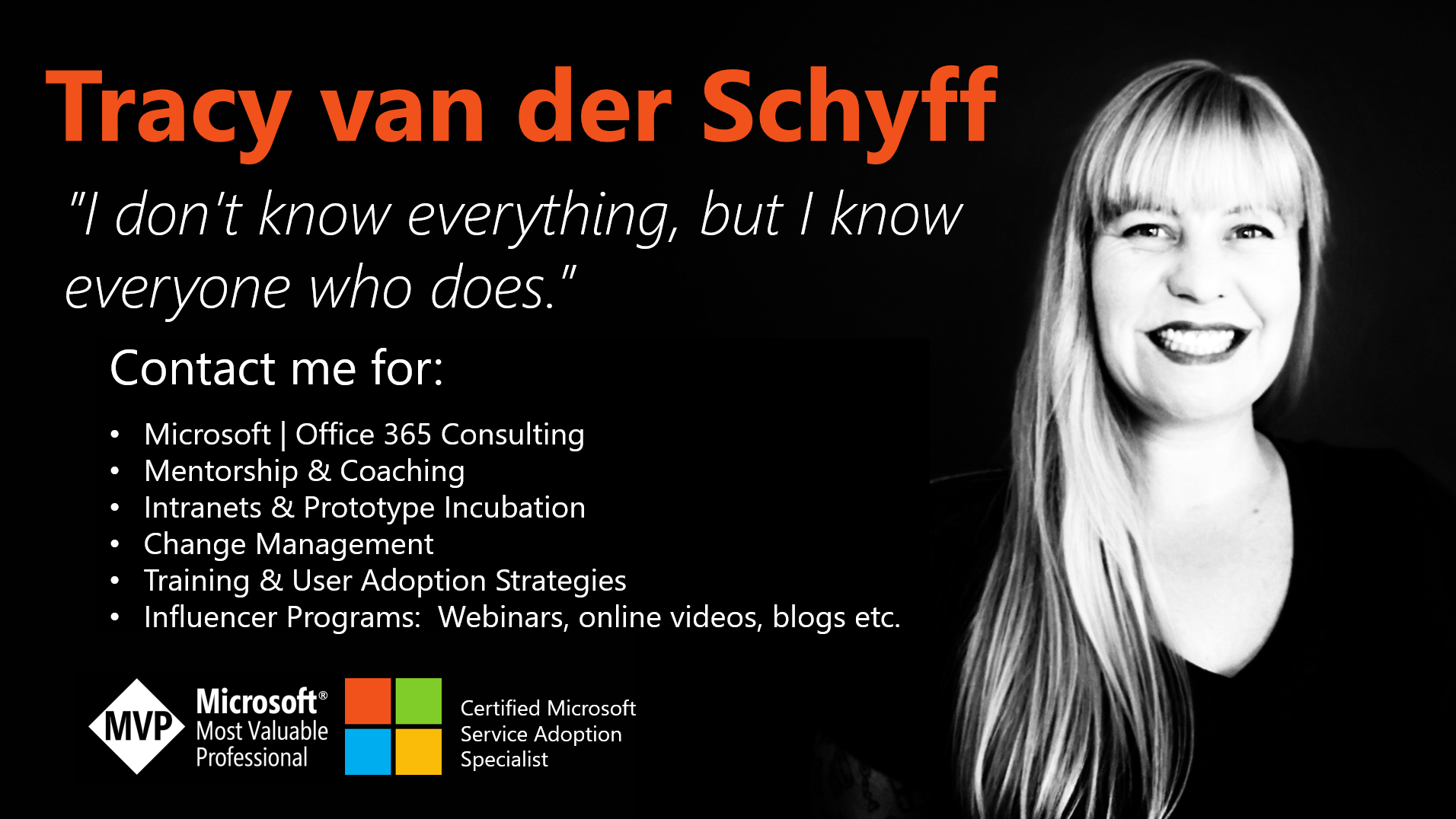Collaboration is something we all do everyday. In this article I asked Microsoft Influencers about the modern workplace and collaboration. Most of the influencers are also MVP’s. I asked all of them the same questions.
This article will help you to think different about collaboration in your company. Or perform better and get new ideas.
The questions I asked them were the following questions:
- Can you tell a small bit about yourself?
- How important is collaboration in the workplace?
- What is essential for productive teamwork?
- How do you think companies are doing collaboration?
- How do organizations win by working together?
- Which Microsoft tools would you advise companies to use and why?
- What is the biggest mistake companies make implementing Office 365?
- What do you think about Bots and AI in the Modern workplace?
- How do you advise companies to stay up to date?
- What would you do if you lead a big fortune 500 company?
You can directly jump to the person by clicking on there names:
Tracy van der Schyff
1. Can you tell a small bit about yourself?
Crazy-pants wearing, motorcycle riding South African. Microsoft’s biggest fan, who’s only life mission is to “Facilitate the evolution of human capabilities.” I am unbelievably grateful to have created a job where I love what I do and can help people = #ikigai
BIO on blog website if you wanted more: https://tracyvanderschyff.com/about/

2. How important is collaboration in the workplace?
#Ubuntu is this beautiful African word that means “I am who I am, because of who we all are.” When we collaborate, we achieve more. That’s the true meaning of Diversity. We add different perspectives and come up with better solutions as a group.
3. What is essential for productive teamwork?
Trust. In each other and technology. For years we haven’t trusted technology because we’ve been let down or not informed. It’s human not to trust other humans, but when we find ourselves in environments where we trust and know the technology, we can relax and trust each other more.
4. How do you think companies are doing collaboration?
Most companies still collaborate through the use of email, which isn’t collaboration at all. Introducing a new tool doesn’t help as we have to change the culture of collaboration & communication. This can be done through Digital Literacy & Soft Skills training as well as personal development / team building techniques. Again, many corporate cultures encourage us “not to share” as this protects our skill or intellectual property. To share and trust is to collaborate.
5. How do organisations win by working together?
Again I’ll refer to Diversity. And with this I don’t just mean gender, race, religion etc. As a white, female, Christian, South African I will add a different perspective to any ‘similar’ persona and that’s true diversity. We are all different, due to physical attributes and those that others cannot see. True collaboration adds a “learning through sharing” aspect to company cultures which gives those companies a competitive edge AND creates environments where employees are happy and less likely to leave.
6. Which Microsoft tools would you advise companies to use and why?
I always suggest to start with Microsoft Teams, OneNote, Planner and OneDrive. It’s the magic combination for true collaboration. “Microsoft Teams is the gateway ‘drug’ that leads to the consumption of the other ‘drugs’ in Office 365 ????”
7. What is the biggest mistake companies make implementing Office 365?
Thinking that they can switch on the licenses and they’re done. I wrote a blog recently about this and had an overwhelming, positive response. Why users are not adopting Microsoft | Office 365. We need to train our users and put effort into changing old, restrictive company cultures.
8. What do you think about Bots and AI in the Modern workplace?
I love the idea, but, to get a computer to ask the right questions, we need to ask the right questions first and have empathy for end users and what they experience. A flawed IT support process will lead to a flawed BOT. Fix the process and culture first, then add technology.
9. How do you advise companies to stay up to date?
By creating mentorship programs where they have product specialists or evangelists for each product. It would be that person’s responsibility to stay up to date daily and share learnings and new features through internal communication methods. Also by training our users to use the Help tab in Office ProPlus, Help Bot in Teams, the “What’s new in Office 365” site as well as the “Microsoft 365 Roadmap”
What would you do if you lead a big fortune 500 company?
Buy more motorcycles…. Kidding. Not kidding.
I would drive a campaign to invest back in my greatest assets, my employees. Digital Literacy programs for the employees and their families, personal and soft skill development, with special focus on building up self-esteem and healing abuse. Performance appraisals will be based on Ikigai Measurement. Love what you do, get paid for it, be good at it and do something the world needs. When we fix people, they are able to do amazing, wonderful things.
I would also be the biggest fan of the products we use, use it myself and visibly show and communicate that. Lead by example.
Oh, how nice to have dreams, imagine changing a company like that?
Matt Wade
1. Can you tell a small bit about yourself?
I’m a native New Yorker (upstate, not the City). I have a bachelors and masters in civil engineering and worked as a mechanical engineer designing nuclear reactor components for the US Navy for a number of years. During that role I started helping with SharePoint adoption and eventually took an Office 365 administrator position at a consulting firm in the US Virgin Islands. After a couple of years in paradise, I moved back to the US mainland to work for H3 Solutions consulting on Office 365. H3S rolled out AtBot, the no-code chatbot solution for the Microsoft Cloud, and I now work in marketing and client engagement on the AI platform. I became a Microsoft MVP for Office 365 in 2018 and you can find me at conferences across North America and Europe speaking on the modern workplace.
2. How important is collaboration in the workplace?
Collaboration is the backbone to optimized organizational success.
3. What is essential for productive teamwork?
Agreeing on the process and how it gets done, then sticking to it. I hate the G-word (governance), but even at the local level, among small departments and units, you need to come to an agreement on how work gets done. If you don’t, people waste time spinning their wheels. And if you don’t hold each other accountable, the process breaks down. Those team-building retreats we see so often need fewer trust falls and more actual talking about how work gets done day-to-day.
4. How do you think companies are doing collaboration?
Large enterprises generally have formal governance and ‘the company way’ of doing things, with the resources to research and put into practice proven methods of success. That doesn’t mean execution is perfect, but it does mean the resources are there internally to support employees. The smaller the organization, the more arbitrary the process is, usually boiling down to how to get things done this time’, which isn’t the most healthy way to do things.
5. How do organizations win by working together?
Collaboration creates success and builds on that success. Add a dash of healthy competition and you end up with better products and process and, ultimately, happier customers.
6. Which Microsoft tools would you advise companies to use and why?
Microsoft Teams, full stop. It brings together modern communication practices, file sharing and editing, video conferencing, and third-party app integrations all in one portal, on pretty much any device you want. It was a game changer upon its release in 2017.
7. What is the biggest mistake companies make implementing Office 365?
I think providing too much choice is a bad thing. Having both Skype for Business and Teams, which have similar features when it comes to video conferencing, or offering offering both GSuite and Office 365 is less helpful than many organizations thing. The falacy of choice can make people waste time and the features they require (the usual justification for choice) may already be available, given enough education.
8. What do you think about Bots and AI in the Modern workplace?
I think the automation powers being kicked off by natural language and voice is the next paradigm in business computing. Right now, many organizations don’t yet see the benefits, but the use cases are endless. Automating tier 1 tech support, answers for common questions, optimizing customer service, these are all processes that right now take up way too much time of actual humans and can be experienced through a bot for insanely cheap prices. It’s a win-win-win.
9. How do you advise companies to stay up to date?
For Office 365, I created this infographic and list of resources. It’s been pretty popular so far. https://jum.to/TheJoneses
10. What would you do if you lead a big fortune 500 company?
Probably resign. I’m not so sure I’m ready to lead an organization like that. Tho I’d demand that golden parachute all those CEOs seem to get. ????
Christian Buckley
1. Can you tell a small bit about yourself?
My name is Christian Buckley. I am a Microsoft Regional Director and Office Apps & Services MVP, and I live just south of Salt Lake City, Utah. Originally from the San Francisco East Bay in California, where I participated in the startup culture for several years, including starting (and selling) two technology companies. I also spent 12 years living in Seattle, Washington, including 3.5 years at Microsoft where I helped launch what is now Office 365.
After departing microsoft, I joined a small SharePoint vendor, went through a couple acquisitions, and helped build some of the biggest brands in the SharePoint space. I currently work as a fractional-CMO (Chief Marketing Officer) with ISVs (independent software vendors) in the Microsoft ecosystem, and am passionate about collaboration and social technologies (SharePoint, Teams, Stream, etc).

2. How important is collaboration in the workplace?
Good collaboration is essential to success. You rarely find examples of successful companies where collaboration is poor. I believe there is a direct link between collaboration and change management – those who are good at collaboration are typically those who are also able to adapt and change more quickly due to technology innovation, or market and competitive shifts. Increasingly, the companies who are able to communicate and collaborate better will win over those who struggle with collaboration. Technology and business is moving at a faster pace now than ever before. Add to that an increasingly distributed workforce, with people working remotely becoming more and more common, and you can see how collaboration is essential.
3. What is essential for productive teamwork?
Much of that depends on the culture of the organization and the roles involved, but at the core of any organization there should be structured and unstructured methods for communication and collaboration. What we learned in the early years of SharePoint is an important lesson for all of us: one method or a single platform will not meet the needs of every person, team, or project. SharePoint as an intranet is great, but it does not perform well as a CRM platform, as a social network, or as dozens of other applications that we tried to force-fit it into in years past.
Instead, productive teamwork requires tools such as SharePoint for more structured collaboration – the idea of having “one version of the truth” for our intellectual property – and other tools for unstructured collaboration. IT Teams need to enforce security and compliance, but these things cannot come at the cost of productivity. If people cannot get their work done due to restrictive and limited technology, what ends up happening is they go around your IT team and use unapproved tools. Within productive teams, there is dialog between end users and IT so that the right tools and solutions are used – but in a managed, secure, and compliant manner.
4. How do you think companies are doing collaboration?
Far too many are simply supporting (or turning a blind eye) whatever tools their end users bring to the table – which are often carry-overs from their previous companies. Many organizations have these incredibly powerful solutions…and then barely scratch the surface of what these solutions can do. I often joke with audiences that SharePoint is the world’s most expensive file share because people use it to upload and retrieve documents, and not much else.
But the trend of “digital transformation” is very positive, with more and more organizations taking the time to understand the tools that they have, how they are using it, what new technology is available, and how the new technology can improve upon what they’re doing today. With this trend toward digital transformation, companies are beginning to understand that healthy collaboration can have a direct impact on the bottom line by helping users to share information and get more engaged.
5. How do organizations win by working together?
Think of it this way: If there are 100 people in your company and only 10 percent are actively creating content and discussing projects, their output and innovation is limited to the combined efforts of those 10. But if 80 to 100 percent of the organization is participating, that is 8x to 10x the content, the conversations, and the innovation being produced. Creativity and innovation are rarely the result of the “mad scientist” working alone in the lab, but are the result of multiple people – and an iterative process that includes collaboration, testing, data, and healthy discussion.
The best organizations that I’ve worked for had amazingly collaborative cultures where people felt empowered to open their mouths and share ideas, try things out, and even to occasionally fail – without fearing for their jobs.
6. Which Microsoft tools would you advise companies to use and why?
As you know, it depends. J Most mid-sized to enterprise organizations need a formal, structured intranet to help communicate and disseminate information. SharePoint is number one for that role. Smaller companies and startups may not necessarily need a formal intranet – both companies of every size can use Teams, which can be great for project-based activities. For external collaboration, managing virtual teams and partners, and several other scenarios, I rely on Yammer.
I’m also a fan of Kanban lists, which Planner provides (though it has some growing to do to catch up with a number of vendor solutions). I’m also a HUGE fan of OneNote and OneDrive. They are essential tools for me. I think companies should also be learning and leveraging PowerApps and Flow, as well as power BI, to automate more and more of their businesses. Of course, there are dozens of smaller tools and services that I might also recommend depending on their requirements, but these are some of the major applications that I recommend.
7. What is the biggest mistake companies make implementing Office 365?
I think this idea of “install it and we’re done” still exists. End users may understand how to leverage the basic features within most of Microsoft products and services, but few of them truly understand how to leverage their full capabilities – much less understand how to best leverage them to meet the company’s needs. Far too often we look at these tools through a technology “lens” rather than approach them through a business lens.
Any digital transformation must begin with a business analysis and shared understanding on what you are trying to accomplish, and how/why existing solutions and processes are not meeting these goals. Once you have an understanding of this, you can explore other solutions – and whether the latest and greatest technology solutions will actually fill the gaps…or perpetuate them.
8. What do you think about Bots and AI in the Modern workplace?
We are still in the early stages of this kind of workplace automation. Two years ago, there was a lot of chatter about “natural language” bots replacing their human counterparts. The reality is that we are far from a “singularity” experience where AI will replace the roles of humans, and mimicking the natural language of humans is a lot harder that people perceive. Having said all that, I think there is much that can be automated, and organizations need to train their employees to understand and leverage these innovations in AI. Automation can have a direct impact on overall productivity, reducing or removing the repetitive tasks.
9. How do you advise companies to stay up to date?
Again, it depends. In general, I tell people to pay attending to the Microsoft 365 updates that come out at least weekly. Even a quick read of these emails will help you to stay up to date on what you are using – or get in front of new products and features. One of my healthy habits is to add calendar reminders weeks or months in advance to check on the status of products and features that were previously announced.
Microsoft is trying to share as much information as possible through the M365 Blog and its many product marketing managers, but more and more of these updates get people excited about a new feature, only to see at the bottom of the article that it will not be released for months. By scheduling reminders, I don’t have to try and remember everything that I am waiting for, but can follow up again to see if a feature that I was excited to see is now live.
I also recommend people find 3 or 4 experts or MVPs that they respect and follow their blogs and podcasts, subscribing to their feeds to receive alerts on any new content. Personally, I watch about a dozen resources for my news and to stay on top of things.
10. What would you do if you lead a big fortune 500 company?
I’d take longer, more frequent vacations.
Alistair Pugin
1. Can you tell a small bit about yourself?
My name is Alistair Pugin. I’m an Azure and Office Apps and Services MVP and I have been working with ECM products since 2000, which makes me really old.

2. How important is collaboration in the workplace?
Collaboration is a broad term and is overused in my opinion. I prefer to think of collaboration as “getting things done”. I would not regard collaboration are part of a predefined workflow process as it leans more towards the ideation vernacular than that of a specific task like processing an insurance claim.
Having said that, people collaborate on a plentitude of tasks. In today’s always ON, anywhere/any time world, its imperative that we have the necessary tooling to collaborate (communicate) more efficiently.
3. What is essential for productive teamwork?
Culture. Teamwork requires reason. Its all about personality traits and how organizations can get the best out of people.
4. How do you think companies are doing collaboration?
It depends squarely on how less of a Neanderthal the company is. Traditional organizations like banks struggle as they are not able to adapt as quick as young companies that have a collaborative ecosystem already built.
5. How do organizations win by working together?
Internally, it fosters innovation and growth. AN incubator of sorts. Externally, (think company to company) it compliments services that organizations need to deliver. Either on behalf of another org or being able to extend the capability of said org to their customers.
6. Which Microsoft tools would you advise companies to use and why?
Its really not about the tools. Breeding an ethos of collaboration is really about changing the culture of the organization to working out loud. Microsoft does have products like Yammer and Teams which would facilitate collaboration.
7. What is the biggest mistake companies make implementing Office 365?
Thinking that Office 365 is only hosted mail and Office ProPlus.
8. What do you think about Bots and AI in the Modern workplace?
We are at the earlier stages of AI as machine learning comes before AI. There are quite a few examples where AI + Bots have assisted in the collaboration space, specifically in Microsoft Teams. As for it replacing human’s, there has been a shift in industry, not only in Information Technology but across other verticals as well. We need to change as humans, adapt to what I now required from industry, and not see it as machines replacing humans.
9. How do you advise companies to stay up to date?
We have gone from a 3 year release cycle to a 3 week release cycle. Companies struggle with moving to a continuous learning culture. Before scouring the interwebs for blogs, podcasts, webinars, etc, I always encourage organizations to get their employees onboard before changing how they do things.
10. What would you do if you lead a big fortune 500 company?
Buy a Lamborghini.
Conclusion Paul
If you want to have an optimal workspace and collaboration, these are the things I learned and you should know:
Stop what you are doing and ask yourself these questions
- Are we truly collaborating?
- Is everybody on the same page?
- Are we getting things done?
How does teamwork look?
- Be aware of the culture in the company
- Have trust in each other
- Use all tools which work for the team
Companies need to look at their collaboration
- Not all tools are used (to bad as they are already paid)
- Education and adoption is critical
- Stop using e-mail as main collaboration tool.
Win by working together
- Diversity is important
- Ideas should be welcomed
- External views help in the process
- Learn through shareing
Tools that are advised to help
- Office 365 as whole package
- Microsoft Teams as the hub for teamwork
- Yammer for discussing
Biggest mistakes companies make
- Just turn features on without a plan
- Only use e-mail as collaboration
- No adoption or education of the tooling
Artificial Intelligence can help
- Helps the process reducing time
- Not only use bots
- Implementation is key. Bad implementation is bad performance
Stay up to date
- Use people who are interested in the latest developments
- Hire a company which comes and explains every month
- Follow Microsoft blogs

